Cockatrice self-propelled flamethrowers (UK)
In June, 1940, the UK evacuated troops from Dunkirk, losing a lot of materiel. It took some time to restore the fleet of vehicles and weapons, but there was a high risk of a German attack. As a result, the army had to look for new ways to protect against landing, not related to the production of relatively complex and expensive systems. One of the promising means of protection found fire. The management of the Petroleum Warfare Department was formed specifically to develop systems using flames. With his direct participation, all new projects of flamethrowing and incendiary weapons were created.
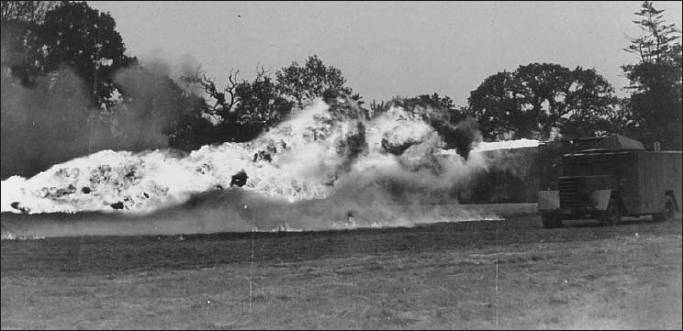
The first prototype of a self-propelled flamethrower from the company Lagonda. Photo by Fletcher D. "Churchill Crocodile Flamethrower"
The Cockatrice project ("Basilisk") was the initiative to develop the automobile company Lagonda. Its director, Reginald P. Frazer, proposed an original design of a jet flamethrower suitable for use in projects of various classes. As a fire mixture it was proposed to use ordinary and thickened gasoline ejected from the nozzle at the same time. The use of such a mixture made it possible to eliminate the ingress of air into the fuel tank and reduce the likelihood of a fire. Such a system built in various dimensions could be used both in portable flamethrowers and on self-propelled equipment.
In August, 1940, the company Lagonda built a prototype of a promising self-propelled flamethrower. On the commercial chassis manufactured by Commer, they installed a metal case, a fire tank of relatively large capacity, gas cylinders to create a working pressure and a hose. Tests of such an improvised combat vehicle showed a high development potential. The ejection of 8 gallons of flammable liquid (36,4 L) made it possible to create a torch about 100 yards in length (91 m) and a maximum diameter of 30 feet (9 m). Due to these characteristics, a new weapon could be of interest from the point of view of combat use, but it nevertheless needed solid refinement.
Designer Neville Shute Norway and a representative of the Admiralty, Lieutenant Jack Cook, attended the tests of the first prototype. They became interested in the proposal of R.P. Fraser and helped with the further development of the project. In particular, it is N.Sh. Norway later found a tactical niche for self-propelled flamethrowers of the new design, and J. Cook made a significant contribution to the development of the technical part of a promising project. Also direct participants in the development of an improved version of the Basilisk machine were Lagonda employees and PWD management specialists.

General view of the machine Light Cockatrice. Photo Strangernn.livejournal.com
Perhaps the main reason for the beginning of the development of a mass of unusual weapons projects at that time was the high probability of an attack by Nazi Germany. At any time, the enemy could launch an amphibious operation using dissimilar forces. N.Sh. Norway took this into account and proposed an original way of countering the enemy landing force. The main means of assault landing at that time were special gliders with which soldiers with weapons and light equipment could be delivered to the specified point. Amphibious gliders had a very simple design and were vulnerable to various influences, however, they were distinguished by low cost and ease of production. It was simple wooden gliders and should have become the target of the latest British self-propelled flamethrowers.
It was assumed that in order to capture bridgeheads on British territory, German troops would first land gliders with fighters and weapons. Marines with these aircraft will have to seize airfields, which will soon begin to land military transport aircraft with reinforcements. N.Sh. Norway noted that for some time after landing the glider and his troops were exposed to various threats, and offered to deal with them at this very moment. Thus, immediately after landing, the self-propelled flamethrower was supposed to drive up to the glider and destroy both the car itself and its passengers or other goods. The effective work of enemy fighters and any serious opposition from them in such conditions were excluded.
To solve the set N.Sh. Norwegian tasks required to create a combat vehicle with some protection and a relatively large stock of portable fire mixture. Also should provide high performance flame throwing. As a result, it was necessary to take a truck as the basis for a self-propelled flamethrower. On the standard chassis should be placed the original armored hull with a set of all the necessary equipment, weapons, etc.
The technical proposal of R.P. Fraser and N.Sh. Norway was soon implemented in the first version of the project "Basilisk", developed with the direct participation of Lieutenant Cook. It should be noted that a new project of a similar machine soon appeared, which had certain differences. Self-propelled flamethrowers of the two versions got their own names: the first was designated as Light Cockatrice (“Light Basilisk”), the second was named Heavy Cockatrice (“Heavy”). First of all, they should have been distinguished by the type of base chassis and some design features of the units installed on it.
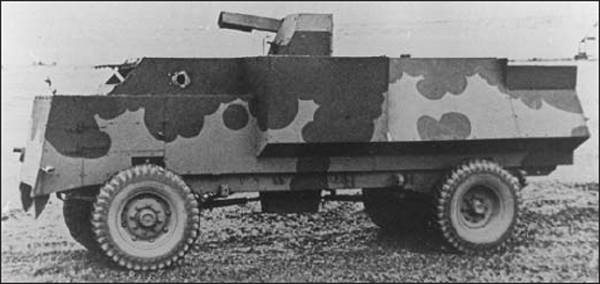
"Easy Basilisk", side view. Photo by Fletcher D. "Churchill Crocodile Flamethrower"
The Bedford QL serial truck, recently launched in the series, was chosen as the basis for the “light” car. It was a bonnetless car with a wheel formula 4x4. A petrol engine of about 70 hp was used. On the cargo platform, the vehicle could carry up to 3 tons of cargo or special equipment or weapons. During the Second World War, these trucks were actively used as vehicles and platforms for mounting weapons or equipment.
During the construction of the Light Basilisks, it was proposed to install a special form of armor on the existing Bedford chassis. Its front part had a box cover to accommodate a radiator, behind it there was a habitable compartment of greater height. The combat compartment of the armored vehicle was on the cargo area, behind the driver’s cabin. It received the board, consisting of two parts. The lower parts were installed with the collapse outward, the larger upper - with a slope inward. On the roof of the fighting compartment placed the turret with the flamethrower hoses.
The result of the joint work of several specialists was the creation of a jet-type flamethrower, similar to other similar systems of the time. Inside the fighting compartment were placed large tanks for the storage of fire mixture, as well as cylinders for compressed carbon dioxide. Under the pressure of the gas, the flammable liquid had to flow into the hoses and be thrown to the target. The intended method of application influenced the design of the flamethrower and related systems. Thus, the fuel tanks could hold the 2 and fire mix, and the fire engine could rise to a vertical position and rotate in any direction in azimuth.
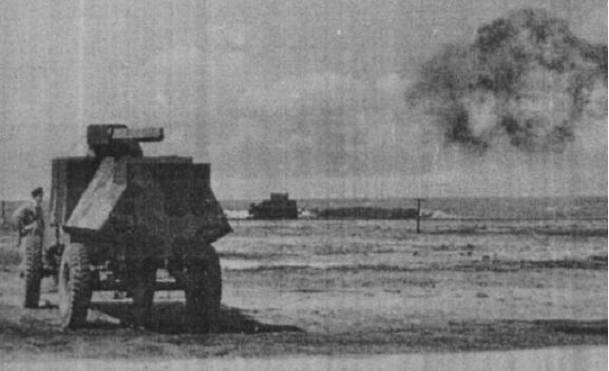
Light Cockatrice during shooting. On the top right you can see a cloud of smoke from the fire mixture. Photo of Nevilshute.org
The new units of a promising combat vehicle in terms of weight and dimensions corresponded to the chassis parameters. The combat weight of the Light Cockatrice self-propelled flamethrower did not exceed 7 t, the mobility remained unchanged. The main weapon of the machine could send a flammable liquid at a distance of up to 90 m, including vertically upwards. In this case, the crew should monitor the pressure in the gas system and the presence of fuel. With insufficient pressure of compressed gas, there was a risk of unburned liquid falling near the machine, which in some circumstances could lead to its ignition.
The AEC Matador truck in a three-axle version, distinguished by higher load-carrying characteristics, was chosen as the base for the Heavy Basilisk. Such a machine could carry up to 4 tons of cargo and was equipped with an 95-strong engine. The undercarriage had a wheel formula 6х6. Triaxial "Matador" were available from the Royal Air Force, where they were used as carriers of fuel tanks and other equipment.
When rebuilding into a self-propelled flamethrower, the truck should have been deprived of the standard cab and cargo area, instead of which it was proposed to install an armored hull. The machine protection had a box-shaped engine cover and a cabin consisting of several parts, as well as a fighting compartment with vertical sides. In the fighting compartment it was necessary to mount the hose on the rotary turret, as well as fire tanks and gas cylinders. The large carrying capacity of the chassis allowed to significantly increase the supply of flammable liquid in comparison with the Light Cockatrice. At the same time, the other elements of the flame throwers of two self-propelled machines were unified.

The "light" flamethrower shoots from a high angle of elevation. Photo by Fletcher D. "Churchill Crocodile Flamethrower"
Due to the large size of the main units, enlarged fire mixture tanks, etc. The Heavy Basilisk had a combat mass at the level of 12 t. The maximum speed did not exceed 40-45 km / h. In addition, due to the large mass, there were some problems with controllability. Characteristics of the flamethrower were the same as that of the lighter machine. At the same time, there were some advantages in the duration of flame throwing.
The development of two projects ended in the fall of 1940. Soon the company Lagonda manufactured prototypes of technology and brought them to the test. The use of a ready-made flamethrower, which did not undergo significant improvements, made it possible to keep the fighting qualities at the level of the first prototype built by R.P. Fraser in a proactive manner. Nevertheless, the equipment was checked again, including in order to determine the driving characteristics.
In general, two cars made the developers. However, it was not without problems. The Heavy Cockatrice 12-ton machine was difficult to manage, with unpleasant consequences. Returning from the landfill to the base after the next test, the driver of the self-propelled flamethrower could not brake in time, and literally blew the checkpoint. The base guard opened fire with personal weapons, and the crew of the prototype had to respond with “warning” fire fire. No one was injured, but this incident could have a noticeable effect on the further fate of the development.
After completing the tests, the PWD department proposed new equipment to other military departments. The Bedford QL self-propelled flamethrower was able to interest the Royal Navy. An order was received for the construction of 60 such machines, which were to guard the sea airfields aviation in the coastal areas of the country. RAF, already operating tankers based on the AEC Matador truck, purchased six Heavy Cockatrice self-propelled flamethrowers on the same chassis. As with fleet, these machines were supposed to guard airfields. There are certain reasons to believe that small volumes of the order for “heavy” vehicles were associated with the incident during the tests.
It should be noted that the Royal Navy became interested in the Basilisk project not only in the context of the protection of airfields. Such weapons were also supposed to be used in the air defense of ships. At the end of 1940, an order appeared for the further development of the existing flamethrower and the creation of its modification, intended for installation on ships and vessels. As far as we know, such developments have not been brought to the test.
Later, work on flamethrowers for the fleet was reassigned to the organization Department of Miscellaneous Weapons Development ("Department of development of various weapons"), which eventually presented an anti-aircraft flamethrower system of stationary or ship accommodation. Due to specific characteristics and capabilities, the resulting Naval pattern vertical firing flamethrower did not leave the testing stage and did not enter service.
At the very end of 1940, the RP Freyer, N.Sh. Norway, J. Cook and their colleagues presented an improved version of the Cockatrice project called Basilisk (another variant of the English name Basilisk). The goal of this project was to improve mobility through the use of a new chassis. A new armored vehicle with flamethrowing weapons was supposed to be introduced into the existing ground units in order to enhance their combat potential. According to some information, the authors of the project managed to build an experimental Basilisk machine, but the project did not progress beyond its testing.
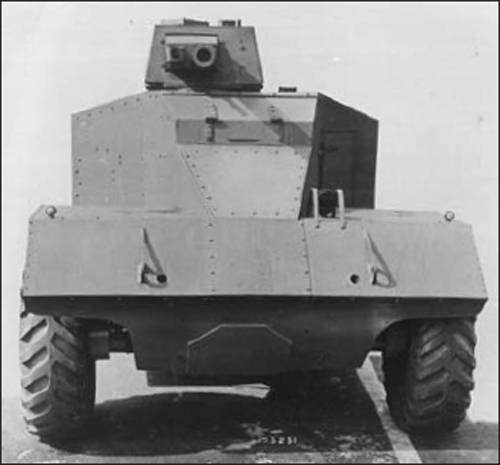
Experienced armored car Basilisk. Photo by Fletcher D. "Churchill Crocodile Flamethrower"
In the framework of Cockatrice family projects, Lagonda built 66 self-propelled flamethrowers of two versions. This technique was used mainly on the aerodromes of naval aviation, while the "ground" aviation units had only six machines. According to available data, the operation of such equipment was not very successful. Moreover, it never had to be used for its intended purpose. Germany did not dare to land a landing, because of which the Basilisks were not given the opportunity to make war with the enemy gliders. Attempts to use their weapons against enemy aircraft, for obvious reasons, were useless.
The operation of the Cockatrice family of vehicles lasted for several years, up to the disappearance of the real risks of attack and the landing of the landing force. In this case, due to the lack of a suitable opponent, the machines were often used for other than their intended purpose. Thus, the presence of a tank for two or more tons of gasoline made it possible to use self-propelled flamethrowers as tank trucks or tankers of aviation equipment. Over time, the existing Basilisks developed their resources and were written off.
The failure of the Basilisk project did not stop the work on the development of self-propelled flamethrowers. Ideas relating to increasing the mobility of the combat vehicle were soon implemented in a new project. Self-propelled flamethrower based on tracked chassis with higher performance called Ronson flamethrower. As part of this project, flamethrower armored vehicles of the new look were brought to the test, and later, after another modernization, and to combat work on the front line.
Based on:
https://nevilshute.org/
http://imcosys.e-bookshelf.ch/
http://nationalarchives.gov.uk/
http://iwm.org.uk/
http://strangernn.livejournal.com/
Fletcher D. Churchill Crocodile Flamethrower. Osprey. 2007.
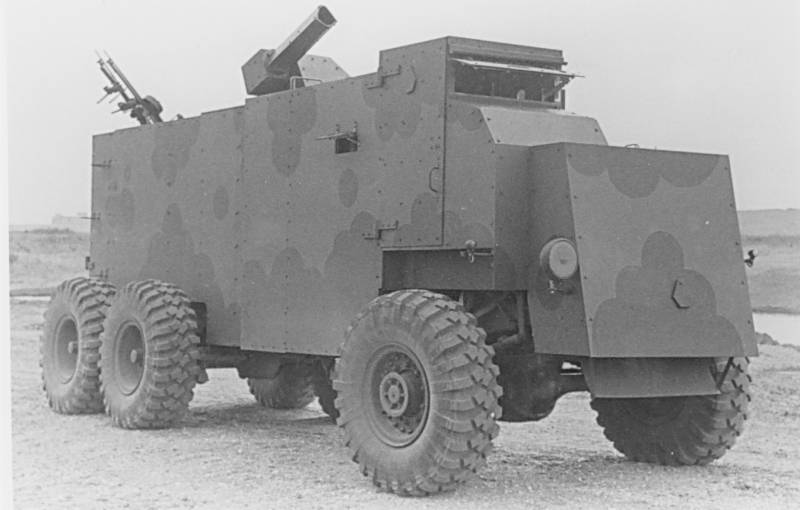
Information